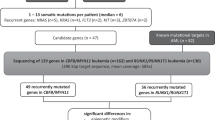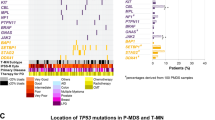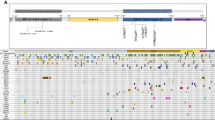Abstract
AML1/RUNX1 mutations have been reported frequently in myelodysplastic syndrome (MDS) patients, especially those diagnosed with refractory anemia with excess blast (RAEB), RAEB in transformation (RAEBt), or AML following MDS (these categories are defined as MDS/AML). Although AML1 mutations are suspected to play a pivotal role in the development of MDS/AML, acquisition of additional genetic alterations is also necessary. We analyzed gene alterations in MDS/AML patients with AML1 mutations, comparing them to alterations in those without an AML1 mutation. AML1 mutations were significantly associated with −7/7q-, whereas MDS/AML patients without AML1 mutations showed a high frequency of −5/5q- and a complex karyotype. Patients with AML1 mutations showed more mutations of their FLT3, N-RAS, PTPN11, and NF1 genes, resulting in a significantly higher mutation frequency for receptor tyrosine kinase (RTK)–RAS signaling pathways in AML1-mutated MDS/AML patients compared to AML1-wild-type MDS/AML patients (38% versus 6.3%, P<0.0001). Conversely, p53 mutations were detected only in patients without AML1 mutations. Furthermore, blast cells of the AML1-mutated patients expressing surface c-KIT, and SHP-2 mutants contributed to prolonged and enhanced extracellular signal-regulated kinase activation following stem cell factor stimulation. Our results suggest that MDS/AML arising from AML1/RUNX1 mutations has a significant association with −7/7q- alteration, and frequently involves RTK–RAS signaling pathway activation.
This is a preview of subscription content, access via your institution
Access options
Subscribe to this journal
Receive 12 print issues and online access
$259.00 per year
only $21.58 per issue
Buy this article
- Purchase on Springer Link
- Instant access to full article PDF
Prices may be subject to local taxes which are calculated during checkout



Similar content being viewed by others
References
Osato M, Asou N, Abdalla E, Hoshino K, Yamasaki H, Okubo T et al. Biallelic and heterozygous point mutations in the runt domain of the AML1/PEBP2alphaB gene associated with myeloblastic leukemias. Blood 1999; 93: 1817–1824.
Preudhomme C, Warot-Loze D, Roumier C, Grardel-Duflos N, Garand R, Lai JL et al. High incidence of biallelic point mutations in the Runt domain of the AML1/PEBP2 alpha B gene in Mo acute myeloid leukemia and in myeloid malignancies with acquired trisomy 21. Blood 2000; 96: 2862–2869.
Silva FP, Morolli B, Storlazzi CT, Anelli L, Wessels H, Bezrookove V et al. Identification of RUNX1/AML1 as a classical tumor suppressor gene. Oncogene 2003; 22: 538–547.
Harada H, Harada Y, Tanaka H, Kimura A, Inaba T . Implications of somatic mutations in the AML1 gene in radiation-associated and therapy-related myelodysplastic syndrome/acute myeloid leukemia. Blood 2003; 101: 673–680.
Christiansen DH, Andersen MK, Pedersen-Bjergaard J . Mutations of AML1 are common in therapy-related myelodysplasia following therapy with alkylating agents and are significantly associated with deletion or loss of chromosome arm 7q and with subsequent leukemic transformation. Blood 2004; 104: 1474–1481.
Song WJ, Sullivan MG, Legare RD, Hutchings S, Tan X, Kufrin D et al. Haploinsufficiency of CBFA2 causes familial thrombocytopenia with propensity to develop acute myelogenous leukaemia. Nat Genet 1999; 23: 166–175.
Osato M . Point mutations in the RUNX1/AML1 gene: another actor in RUNX leukemia. Oncogene 2004; 23: 4284–4296.
Harada H, Harada Y, Niimi H, Kyo T, Kimura A, Inaba T . High incidence of somatic mutations in the AML1/RUNX1 gene in myelodysplastic syndrome and low blast percentage myeloid leukemia with myelodysplasia. Blood 2004; 103: 2316–2324.
Ichikawa M, Asai T, Saito T, Yamamoto G, Seo S, Yamazaki I et al. AML-1 is required for megakaryocytic maturation and lymphocytic differentiation, but not for maintenance of hematopoietic stem cells in adult hematopoiesis. Nat Med 2004; 10: 299–304.
Higuchi M, O'Brien D, Kumaravelu P, Lenny N, Yeoh EJ, Downing JR . Expression of a conditional AML1-ETO oncogene bypasses embryonic lethality and establishes a murine model of human t(8;21) acute myeloid leukemia. Cancer Cell 2002; 1: 63–74.
Beghini A, Peterlongo P, Ripamonti CB, Larizza L, Cairoli R, Morra E et al. C-kit mutations in core binding factor leukemias. Blood 2000; 95: 726–727.
Gilliland DG . Hematologic malignancies. Curr Opin Hematol 2001; 8: 189–191.
Matsuno N, Osato M, Yamashita N, Yanagida M, Nanri T, Fukushima T et al. Dual mutations in the AML1 and FLT3 genes are associated with leukemogenesis in acute myeloblastic leukemia of the M0 subtype. Leukemia 2003; 17: 2492–2499.
Fenaux P . Chromosome and molecular abnormalities in myelodysplastic syndromes. Int J Hematol 2001; 73: 429–437.
Hirai H . Molecular mechanisms of myelodysplastic syndrome. Jpn J Clin Oncol 2003; 33: 153–160.
Rosenfeld C, List A . A hypothesis for the pathogenesis of myelodysplastic syndromes: implications for new therapies. Leukemia 2000; 14: 2–8.
Mitelman F (ed). An International System for Human Cytogenetic Nomenclature (1995): Recommendations of the International Standing Committee on Human Cytogenetic Nomenclature. Basel, Switzerland: S Karger,, 1995.
Bowen DT, Frew ME, Rollinson S, Roddam PL, Dring A, Smith MT et al. CYP1A1*2B (Val) allele is overrepresented in a subgroup of acute myeloid leukemia patients with poor-risk karyotype associated with NRAS mutation, but not associated with FLT3 internal tandem duplication. Blood 2003; 101: 2770–2774.
Pullarkat VA, Bueso-Ramos C, Lai R, Kroft S, Wilson CS, Pullarkat ST et al. Systemic mastocytosis with associated clonal hematological non-mast-cell lineage disease: analysis of clinicopathologic features and activating c-kit mutations. Am J Hematol 2003; 73: 12–17.
Tartaglia M, Kalidas K, Shaw A, Song X, Musat DL, van der Burgt I et al. PTPN11 mutations in Noonan syndrome: molecular spectrum, genotype-phenotype correlation, and phenotypic heterogeneity. Am J Hum Genet 2002; 70: 1555–1563.
De Luca A, Buccino A, Gianni D, Mangino M, Giustini S, Richetta A et al. NF1 gene analysis based on DHPLC. Hum Mutat 2003; 21: 171–172.
Christiansen DH, Andersen MK, Pedersen-Bjergaard J . Mutations with loss of heterozygosity of p53 are common in therapy-related myelodysplasia and acute myeloid leukemia after exposure to alkylating agents and significantly associated with deletion or loss of 5q, a complex karyotype, and a poor prognosis. J Clin Oncol 2001; 19: 1405–1413.
Kiyoi H, Naoe T, Nakano Y, Yokota S, Minami S, Miyawaki S et al. Prognostic implication of FLT3 and N-RAS gene mutations in acute myeloid leukemia. Blood 1999; 93: 3074–3080.
Yamamoto Y, Kiyoi H, Nakano Y, Suzuki R, Kodera Y, Miyawaki S et al. Activating mutation of D835 within the activation loop of FLT3 in human hematologic malignancies. Blood 2001; 97: 2434–2439.
Tartaglia M, Niemeyer CM, Fragale A, Song X, Buechner J, Jung A et al. Somatic mutations in PTPN11 in juvenile myelomonocytic leukemia, myelodysplastic syndromes and acute myeloid leukemia. Nat Genet 2003; 34: 148–150.
Fragale A, Tartaglia M, Wu J, Gelb BD . Noonan syndrome-associated SHP2/PTPN11 mutants cause EGF-dependent prolonged GAB1 binding and sustained ERK2/MAPK1 activation. Hum Mutat 2004; 23: 267–277.
Chan RJ, Leedy MB, Munugalavadla V, Voorhorst CS, Li Y, Yu M et al. Human somatic PTPN11 mutations induce hematopoietic cell hypersensitivity to granulocyte-macrophage colony stimulating factor. Blood 2005; 105: 3737–3742.
Loh ML, Vattikuti S, Schubbert S, Reynolds MG, Carlson E, Lieuw KH et al. Mutations in PTPN11 implicate the SHP-2 phosphatase in leukemogenesis. Blood 2004; 103: 2325–2331.
Pedersen-Bjergaard J, Andersen MK, Christiansen DH, Nerlov C . Genetic pathways in therapy-related myelodysplasia and acute myeloid leukemia. Blood 2002; 99: 1909–1912.
Pedersen-Bjergaard J, Christiansen DH, Andersen MK, Skovby F . Causality of myelodysplasia and acute myeloid leukemia and their genetic abnormalities. Leukemia 2002; 16: 2177–2184.
Qian Z, Fernald AA, Godley LA, Larson RA, Le Beau MM . Expression profiling of CD34+ hematopoietic stem/progenitor cells reveals distinct subtypes of therapy-related acute myeloid leukemia. Proc Natl Acad Sci USA 2002; 99: 14925–14930.
Stephenson J, Lizhen H, Mufti GJ . Possible co-existence of RAS activation and monosomy 7 in the leukaemic transformation of myelodysplastic syndromes. Leuk Res 1995; 19: 741–748.
Christiansen DH, Andersen MK, Pedersen-Bjergaard J . Methylation of p15INK4B is common, is associated with deletion of genes on chromosome arm 7q and predicts a poor prognosis in therapy-related myelodysplasia and acute myeloid leukemia. Leukemia 2003; 17: 1813–1819.
Horiike S, Misawa S, Kaneko H, Sasai Y, Kobayashi M, Fujii H et al. Distinct genetic involvement of the TP53 gene in therapy-related leukemia and myelodysplasia with chromosomal losses of Nos 5 and/or 7 and its possible relationship to replication error phenotype. Leukemia 1999; 13: 1235–1242.
Hirai H, Kobayashi Y, Mano H, Hagiwara K, Maru Y, Omine M et al. A point mutation at codon 13 of the N-ras oncogene in myelodysplastic syndrome. Nature 1987; 327: 430–432.
Johan MF, Bowen DT, Frew ME, Goodeve AC, Wilson GA, Peake IR et al. Mutations in PTPN11 are uncommon in adult myelodysplastic syndromes and acute myeloid leukaemia. Br J Haematol 2004; 124: 843–844.
Watkins F, Fidler C, Boultwood J, Wainscoat JS . Mutations in PTPN11 are rare in adult myelodysplastic syndromes and acute myeloid leukemia. Am J Hematol 2004; 76: 417.
Loh ML, Martinelli S, Cordeddu V, Reynolds MG, Vattikuti S, Lee CM et al. Acquired PTPN11 mutations occur rarely in adult patients with myelodysplastic syndromes and chronic myelomonocytic leukemia. Leuk Res 2005; 29: 459–462.
Kaneko H, Horiike S, Nakai H, Ueda Y, Nakao M, Hirakawa K et al. Neurofibromatosis 1 gene (NF1) mutation is a rare genetic event in myelodysplastic syndrome regardless of the disease progression. Int J Hematol 1995; 61: 113–116.
Yokota S, Kiyoi H, Nakao M, Iwai T, Misawa S, Okuda T et al. Internal tandem duplication of the FLT3 gene is preferentially seen in acute myeloid leukemia and myelodysplastic syndrome among various hematological malignancies. A study on a large series of patients and cell lines. Leukemia 1997; 11: 1605–1609.
Horiike S, Yokota S, Nakao M, Iwai T, Sasai Y, Kaneko H et al. Tandem duplications of the FLT3 receptor gene are associated with leukemic transformation of myelodysplasia. Leukemia 1997; 11: 1442–1446.
Jacks T, Shih TS, Schmitt EM, Bronson RT, Bernards A, Weinberg RA . Tumour predisposition in mice heterozygous for a targeted mutation in Nf1. Nat Genet 1994; 7: 353–361.
Le DT, Kong N, Zhu Y, Lauchle JO, Aiyigari A, Braun BS et al. Somatic inactivation of Nf1 in hematopoietic cells results in a progressive myeloproliferative disorder. Blood 2004; 103: 4243–4250.
Braun BS, Tuveson DA, Kong N, Le DT, Kogan SC, Rozmus J et al. Somatic activation of oncogenic Kras in hematopoietic cells initiates a rapidly fatal myeloproliferative disorder. Proc Natl Acad Sci USA 2004; 101: 597–602.
Chan IT, Kutok JL, Williams IR, Cohen S, Kelly L, Shigematsu H et al. Conditional expression of oncogenic K-ras from its endogenous promoter induces a myeloproliferative disease. J Clin Invest 2004; 113: 528–538.
Araki T, Mohi MG, Ismat FA, Bronson RT, Williams IR, Kutok JL et al. Mouse model of Noonan syndrome reveals cell type- and gene dosage-dependent effects of Ptpn11 mutation. Nat Med 2004; 10: 849–857.
Donovan S, See W, Bonifas J, Stokoe D, Shannon KM . Hyperactivation of protein kinase B and ERK have discrete effects on survival, proliferation, and cytokine expression in Nf1-deficient myeloid cells. Cancer Cell 2002; 2: 507–514.
Yokomizo T, Ogawa M, Osato M, Kanno T, Yoshida H, Fujimoto T et al. Requirement of Runx1/AML1/PEBP2alphaB for the generation of haematopoietic cells from endothelial cells. Genes Cells 2001; 6: 13–23.
Care RS, Valk PJ, Goodeve AC, Abu-Duhier FM, Geertsma-Kleinekoort WM, Wilson GA et al. Incidence and prognosis of c-KIT and FLT3 mutations in core binding factor (CBF) acute myeloid leukaemias. Br J Haematol 2003; 121: 775–777.
Wang YY, Zhou GB, Yin T, Chen B, Shi JY, Liang WX et al. AML1-ETO and C-KIT mutation/overexpression in t(8;21) leukemia: implication in stepwise leukemogenesis and response to Gleevec. Proc Natl Acad Sci USA 2005; 102: 1104–1109.
Kohl TM, Schnittger S, Ellwart JW, Hiddemann W, Spiekermann K . KIT exon 8 mutations associated with core binding factor (CBF) – acute myeloid leukemia (AML) cause hyperactivation of the receptor in response to stem cell factor. Blood 2004; 105: 3319–3321.
Yang G, Khalaf W, van de Locht L, Jansen JH, Gao M, Thompson MA et al. Transcriptional Repression of the neurofibromatosis-1 tumor suppressor by the t(8;21) fusion protein. Mol Cell Biol 2005; 25: 5869–5879.
Johnson EJ, Scherer SW, Osborne L, Tsui LC, Oscier D, Mould S et al. Molecular definition of a narrow interval at 7q22*1 associated with myelodysplasia. Blood 1996; 87: 3579–3586.
Grisendi S, Bernardi R, Rossi M, Cheng K, Khandker L, Manova K et al. Role of nucleophosmin in embryonic development and tumorigenesis. Nature 2005; 437: 147–153.
Acknowledgements
This work was supported in part by Grants-in-Aid for Scientific Research from the Ministry of Education, Culture, Sports, Science and Technology of Japan, the Osaka Cancer Research Foundation, and the Tsuchiya Foundation. We are grateful to Ryoko Matsumoto-Yamaguchi for excellent technical support in carrying out these experiments. We also thank Dr Ross Fisher and Dr Hideaki Nakajima for critical reading of the article.
Author information
Authors and Affiliations
Corresponding author
Additional information
Supplementary Information accompanies the paper on Leukemia website (http://www.nature.com/leu)
Supplementary information
Rights and permissions
About this article
Cite this article
Niimi, H., Harada, H., Harada, Y. et al. Hyperactivation of the RAS signaling pathway in myelodysplastic syndrome with AML1/RUNX1 point mutations. Leukemia 20, 635–644 (2006). https://doi.org/10.1038/sj.leu.2404136
Received:
Revised:
Accepted:
Published:
Issue Date:
DOI: https://doi.org/10.1038/sj.leu.2404136
Keywords
This article is cited by
-
Clinico-pathologic characteristics and outcomes of the World Health Organization (WHO) provisional entity de novo acute myeloid leukemia with mutated RUNX1
Modern Pathology (2020)
-
−7/7q− syndrome in myeloid-lineage hematopoietic malignancies: attempts to understand this complex disease entity
Oncogene (2015)
-
Ezh2 loss promotes development of myelodysplastic syndrome but attenuates its predisposition to leukaemic transformation
Nature Communications (2014)
-
RUNX1 meets MLL: epigenetic regulation of hematopoiesis by two leukemia genes
Leukemia (2013)
-
Assessing karyotype precision by microarray-based comparative genomic hybridization in the myelodysplastic/myeloproliferative syndromes
Molecular Cytogenetics (2010)



